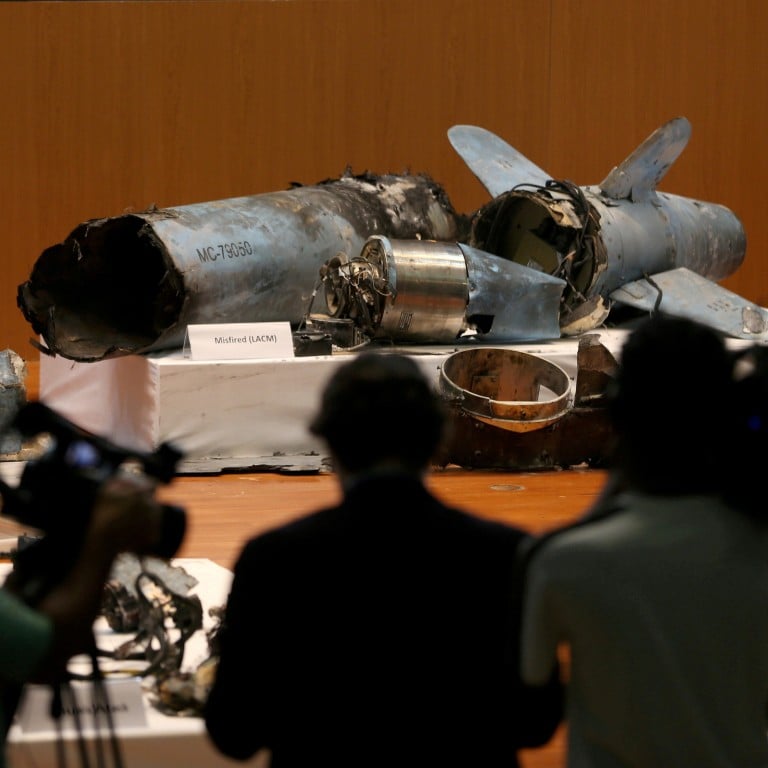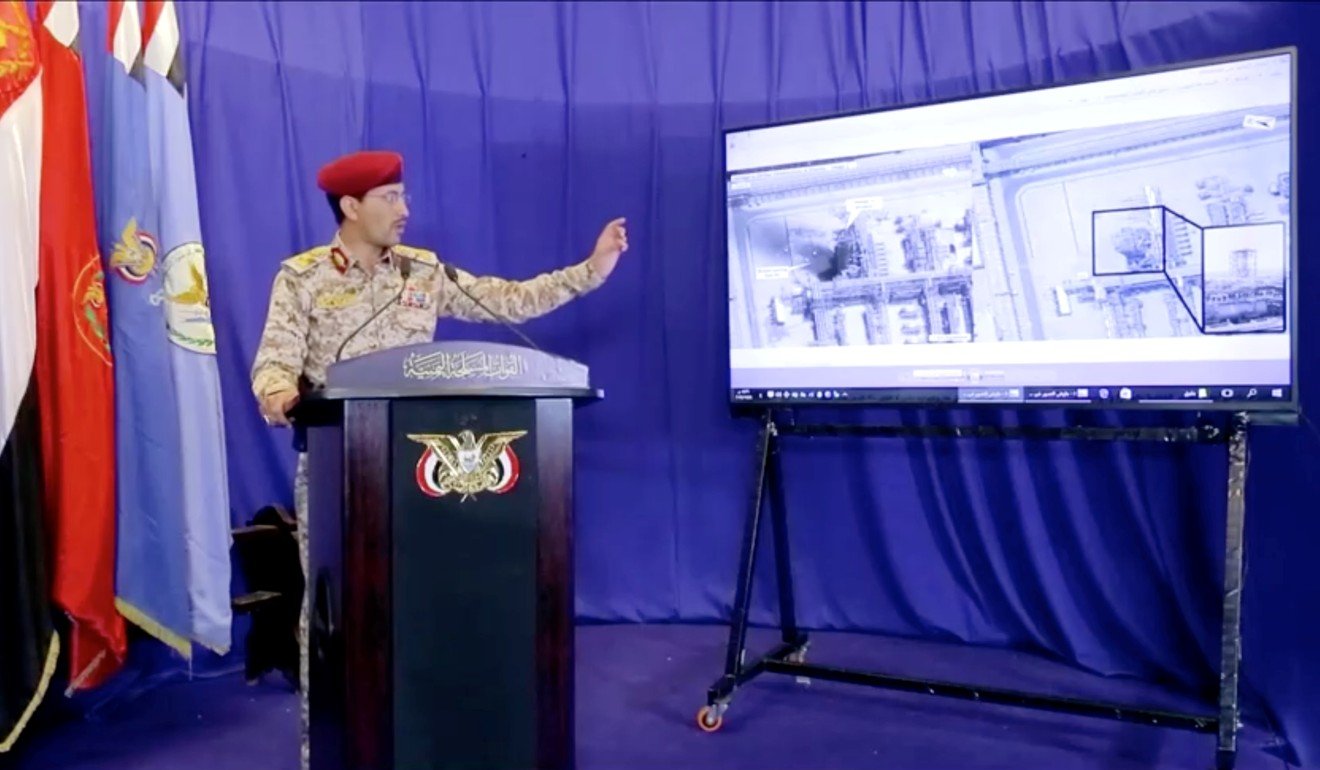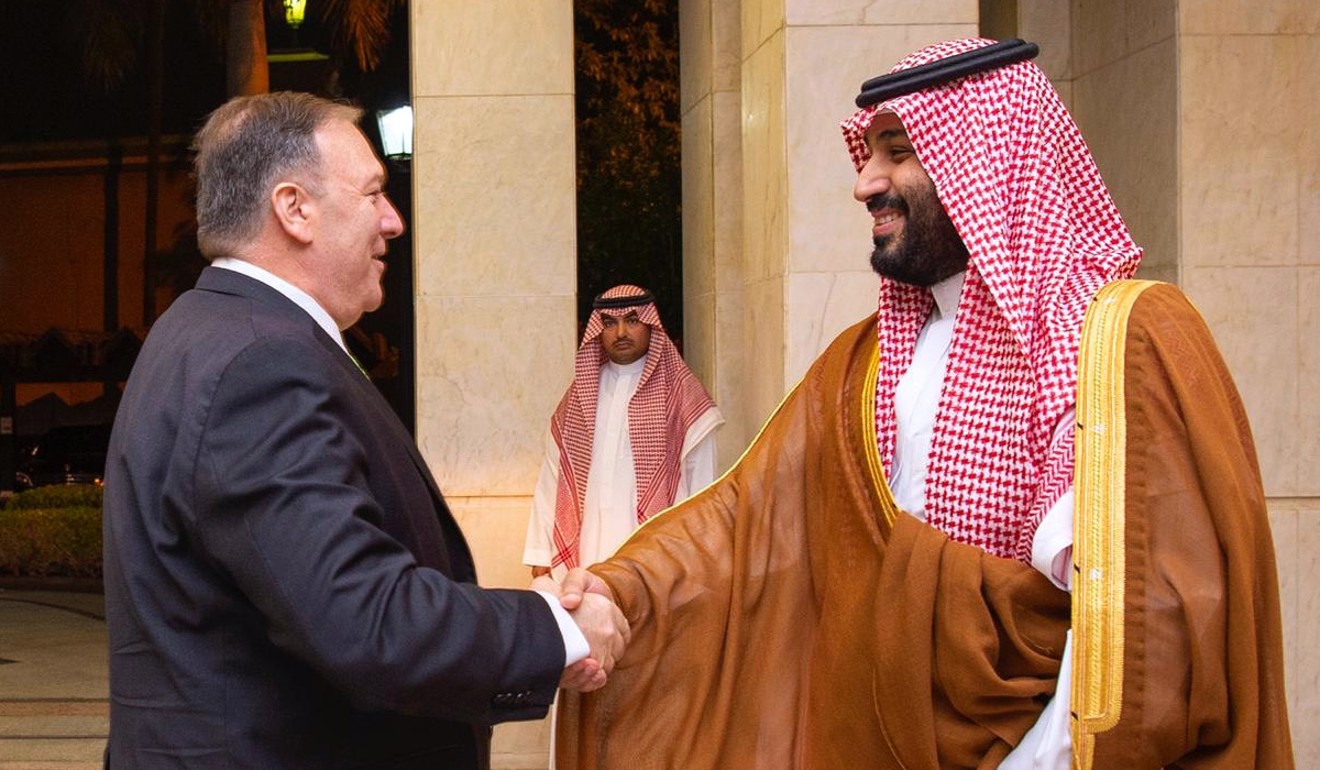
Mike Pompeo calls oil site attacks an ‘act of war’ as Saudis display ‘proof’ that Iran was behind strikes
- Drone and missile remnants show attacks were ‘unquestionably sponsored’ by Tehran, US ally says
- Trump announces new sanctions, says there are ‘many options’ short of war with Iran
US Secretary of State Mike Pompeo called strikes on Saudi Arabia’s oil sites an “act of war” on Wednesday, as the US ally displayed remnants of drones and missiles it said were used in a crippling attack that was “unquestionably sponsored” by Tehran.
The senior official made his comments after US President Donald Trump said on Twitter that he had ordered the US Treasury to “substantially increase sanctions on the country of Iran!” and told reporters the unspecified, punitive economic measures would be unveiled within 48 hours.
Trump’s tweet followed repeated US assertions that the Islamic Republic was behind Saturday’s attack and came hours after Saudi Arabia said the strike was a “test of global will”.
The president said on Wednesday, however, that there were many options short of war with Iran
“There are many options. There’s the ultimate option and there are options that are a lot less than that. And we’ll see,” Trump told reporters in Los Angeles. “I’m saying the ultimate option meaning go in – war.”
Iran again denied involvement in the September 14 raids, which hit the world’s biggest crude oil processing facility and initially knocked out half of Saudi output. Saudi Arabia is the world’s leading oil exporter.
Responsibility was claimed by Yemen’s Iran-aligned Houthi group, which on Wednesday gave more details of the raid, saying it was launched from three sites in Yemen. In a remark that may further strain an already tense political atmosphere in the Gulf, the Houthis also said they had dozens of sites in the United Arab Emirates, Riyadh’s top Arab ally, listed as possible targets for attacks.
In an attempt to bolster its assertion that Iran was responsible, Saudi Arabia showed drone and missile debris it said amounted to undeniable evidence of Iranian aggression.
Yemen’s Houthi rebels threaten new attacks on Saudi oil sites
A total of 25 drones and missiles were used in the attacks launched from Iran, not Yemen, Defence Ministry spokesman Colonel Turki al-Malki told a news conference.
“The attack was launched from the north and unquestionably sponsored by Iran,” he said, adding Iranian Delta Wing unmanned aerial vehicles (UAV) were used in addition to cruise missiles.
An investigation into the origin of the attacks was still under way and the result will be announced later, he said.
The attack exposed gaps in Saudi air defences despite billions spent on Western military hardware.

Proof of Iranian responsibility, and in particular firm evidence that the attack was launched from Iranian territory, could pressure Riyadh and Washington into a response. Both nations, however, were stressing the need for caution.
Trump has previously said he does not want war and is coordinating with Gulf and European states.
Crown Prince Mohammed bin Salman, Saudi Arabia’s de facto ruler, said the strike was a “real test of the global will” to confront subversion of the international order.
His envoy to London, Prince Khalid bin Bander, told the BBC the attack was “almost certainly” Iranian-backed: “We’re trying not to react too quickly because the last thing we need is more conflict in the region.”
Drone strikes in Saudi Arabia ‘may push China to diversify oil supply’
The Islamic republic dismissed the allegations.
“They want to impose maximum … pressure on Iran through slander,” Iranian President Hassan Rowhani said.
“We don’t want conflict in the region … Who started the conflict?” he added, blaming Washington and its Gulf allies for the war in Yemen.
Yemen’s Houthi movement, battling a Western-backed, Saudi-led coalition for more than four years, said it used drones to assault state oil company Aramco’s sites.

The raid exposed the vulnerability of Saudi Arabia’s oil infrastructure and threw down a gauntlet to the United States, which wants to curb Iranian influence in the region.
“The attack is like September 11 for Saudi Arabia, it is a game changer,” said one Saudi security analyst.
Pompeo, who met Prince Mohammed in Jeddah to discuss the crisis, said the attacks would be a major focus of next week’s annual UN General Assembly meeting and suggested Saudi Arabia could make its case there.
Pompeo called the attacks “an act of war”.
Aramco IPO almost impossible as investors fear more attacks
“The Saudis were the nation that was attacked. It was on their soil. It was an act of war against them directly, and I’m confident they will do that,” he told reporters before meeting the Saudi crown prince.
UN officials monitoring sanctions on Iran and Yemen were also heading to Saudi Arabia to investigate. Secretary-General Antonio Guterres warned that a major confrontation in the Gulf would have “devastating consequences” for the region and globally.
France, which is trying to salvage an international nuclear deal with Iran that Washington quit last year, said it wanted to establish the facts before reacting.
A US official said on Tuesday the strikes originated in southwestern Iran. Three officials said they involved cruise missiles and drones, indicating a higher degree of complexity and sophistication than initially thought. The officials did not provide evidence or explain what US intelligence they were using for evaluating the attack.
Saudi Arabia’s finance minister said the attack had no impact on revenues and Aramco was continuing to supply markets without interruption.
US efforts to bring about a UN Security Council response looked unlikely to succeed as Russia and China have veto powers and were expected to shield Iran.
Russian President Vladimir Putin, who has offered to sell defence systems to Riyadh, called for a “thorough and impartial” probe during a phone call with Prince Mohammed.
The 2015 nuclear deal ushered in a brief detente in long hostile relations between Iran and the United States. But antagonism returned when Trump pulled out of the pact, reached before he took office, and reimposed sanctions, severely damaging the Iranian economy. Iran has ruled out talks with Washington unless it returns to the pact.
Trump says US ‘locked and loaded’ as photos show damage to Saudi facilities
Trump said he is not looking to meet Rowhani during a UN event in New York this month. Rowhani and his foreign minister may not attend the General Assembly at all unless US visas are issued in the coming hours, Iranian state media reported on Wednesday.
Washington and its Gulf allies want Iran to stop supporting regional proxies, including in Yemen, Iraq and Lebanon.
Despite years of air strikes against it, the Houthi movement boasts drones and missiles able to reach deep into Saudi Arabia, the result of an arms race since the Western-backed coalition intervened in Yemen in March 2015.
Iran’s clerical rulers support the Houthis, who ousted Yemen’s internationally recognised government from power in the capital, Sanaa, in late 2014. But Tehran denies that it actively arms and finances the Houthi movement.


